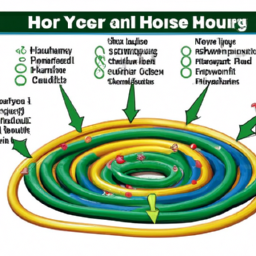Garden Hose Flow How Many Gallons Per Hour
How Many Gallons Per Hour Garden Hose
How Many Gallons Per Hour is Rarely Disclosed on Garden Hose Packaging, Here's Why
Garden hoses can be a homeowner's best friend or enemy when it comes to water related tasks like cleaning, fountains, and watering plants. Knowing the gallons-per-hour rating of a garden hose can be vital to selecting the perfect hose for your needs, yet it is rarely disclosed on the hose or packaging. So why is this key information so difficult to find out? Here we explore the history of garden hoses, design elements that can lead to widely varying gallons-per-hour ratings, and what homeowners should consider when searching for the perfect garden hose.
History of Garden Hoses
The humble garden hose has come a long way over the years. Early hoses were made of leather in the mid-1800s. Modern rubber and vinyl hoses began to appear by the early 1900s. But while technology and materials have evolved, measurements for water flow have unfortunately remained unclear.
Why the Confusion
When it comes to garden hoses, Gallons-Per-Hour (GPH) is the unit of measure used to gauge the quantity of water flow. Since GPH is typically measured directly from the faucet, it can be difficult to estimate GPH for garden hoses because there are so many factors that can affect water flow, such as hose diameter, length, and kinks or twists in the hose.
Design Considerations
Two features of garden hoses are diameter and length. Both of these features are directly related to the amount of water that a garden hose can deliver.
Diameter
Garden hoses are generally designatedby their diameter, which is measured in either fractions of an inch (3/8, 5/8, etc.) or millimeters (10mm, 12mm, etc.). Hoses with large diameters have higher GPH ratings than hoses with small diameters, because more water can be moved through them.
Length
Garden hoses come in a variety of lengths, from 25 feet to over 100 feet. Generally, longer hoses are less efficient than shorter hoses in terms of GPH ratings because the force of the incoming water has to be spread over a greater length.
Gauging Your GPH Rating
Since GPH ratings are not typically indicated on garden hose packaging, you can use the following table to calculate an estimated GPH rating for your garden hose:
| Hose Diameter (in.) | GPH (25 ft) | GPH (50 ft) |
| 3/8 | 20.8 | 15.0 |
| 1/2 | 29.3 | 21.5 |
| 5/8 | 37.8 | 27.0 |
| 3/4 | 46.4 | 32 |
Closing Remarks
Now that you've done your research on garden hoses, you likely don't feel left in the dark when it comes to selecting the appropriate model for your needs. Consider diameter and length when you select a garden hose, and if promising specs aren't listed on the packaging, use this chart to make an estimate. With a great hose in hand, you can get to work on those outdoor water related tasks!
References
- What is the History of the Garden Hose? WaterRight Inc.
- Hose Gauge Crown Products.
- Garden Hose Gallons-Per-Hour True Living.

Previous Page
